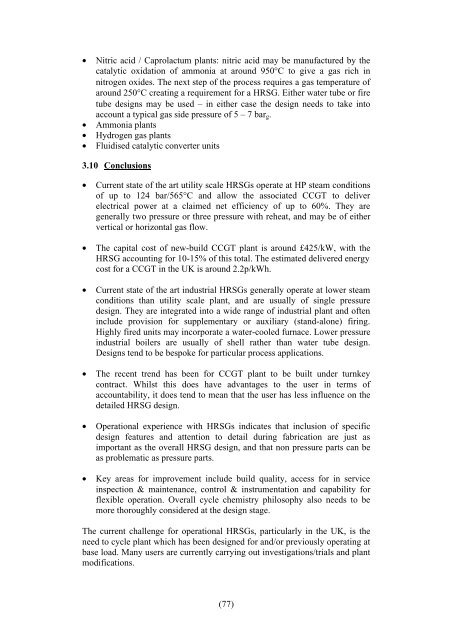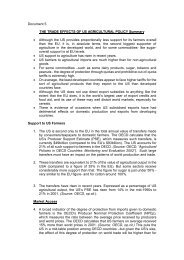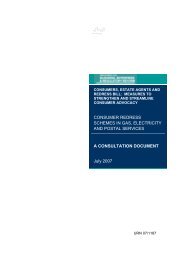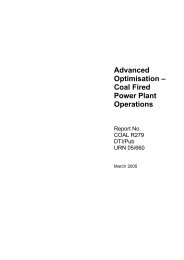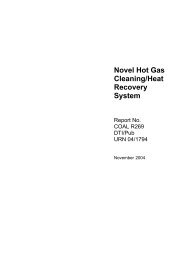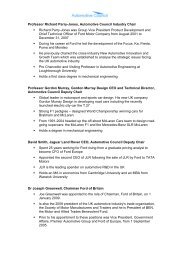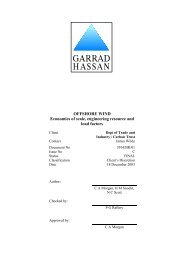(70) Therefore, the risk of sulphuric acid dew point attack ... - DTI Home
(70) Therefore, the risk of sulphuric acid dew point attack ... - DTI Home
(70) Therefore, the risk of sulphuric acid dew point attack ... - DTI Home
You also want an ePaper? Increase the reach of your titles
YUMPU automatically turns print PDFs into web optimized ePapers that Google loves.
• Nitric <strong>acid</strong> / Caprolactum plants: nitric <strong>acid</strong> may be manufactured by <strong>the</strong><br />
catalytic oxidation <strong>of</strong> ammonia at around 950°C to give a gas rich in<br />
nitrogen oxides. The next step <strong>of</strong> <strong>the</strong> process requires a gas temperature <strong>of</strong><br />
around 250°C creating a requirement for a HRSG. Ei<strong>the</strong>r water tube or fire<br />
tube designs may be used – in ei<strong>the</strong>r case <strong>the</strong> design needs to take into<br />
account a typical gas side pressure <strong>of</strong> 5 – 7 barg.<br />
• Ammonia plants<br />
• Hydrogen gas plants<br />
• Fluidised catalytic converter units<br />
3.10 Conclusions<br />
• Current state <strong>of</strong> <strong>the</strong> art utility scale HRSGs operate at HP steam conditions<br />
<strong>of</strong> up to 124 bar/565°C and allow <strong>the</strong> associated CCGT to deliver<br />
electrical power at a claimed net efficiency <strong>of</strong> up to 60%. They are<br />
generally two pressure or three pressure with reheat, and may be <strong>of</strong> ei<strong>the</strong>r<br />
vertical or horizontal gas flow.<br />
• The capital cost <strong>of</strong> new-build CCGT plant is around £425/kW, with <strong>the</strong><br />
HRSG accounting for 10-15% <strong>of</strong> this total. The estimated delivered energy<br />
cost for a CCGT in <strong>the</strong> UK is around 2.2p/kWh.<br />
• Current state <strong>of</strong> <strong>the</strong> art industrial HRSGs generally operate at lower steam<br />
conditions than utility scale plant, and are usually <strong>of</strong> single pressure<br />
design. They are integrated into a wide range <strong>of</strong> industrial plant and <strong>of</strong>ten<br />
include provision for supplementary or auxiliary (stand-alone) firing.<br />
Highly fired units may incorporate a water-cooled furnace. Lower pressure<br />
industrial boilers are usually <strong>of</strong> shell ra<strong>the</strong>r than water tube design.<br />
Designs tend to be bespoke for particular process applications.<br />
• The recent trend has been for CCGT plant to be built under turnkey<br />
contract. Whilst this does have advantages to <strong>the</strong> user in terms <strong>of</strong><br />
accountability, it does tend to mean that <strong>the</strong> user has less influence on <strong>the</strong><br />
detailed HRSG design.<br />
• Operational experience with HRSGs indicates that inclusion <strong>of</strong> specific<br />
design features and attention to detail during fabrication are just as<br />
important as <strong>the</strong> overall HRSG design, and that non pressure parts can be<br />
as problematic as pressure parts.<br />
• Key areas for improvement include build quality, access for in service<br />
inspection & maintenance, control & instrumentation and capability for<br />
flexible operation. Overall cycle chemistry philosophy also needs to be<br />
more thoroughly considered at <strong>the</strong> design stage.<br />
The current challenge for operational HRSGs, particularly in <strong>the</strong> UK, is <strong>the</strong><br />
need to cycle plant which has been designed for and/or previously operating at<br />
base load. Many users are currently carrying out investigations/trials and plant<br />
modifications.<br />
(77)


